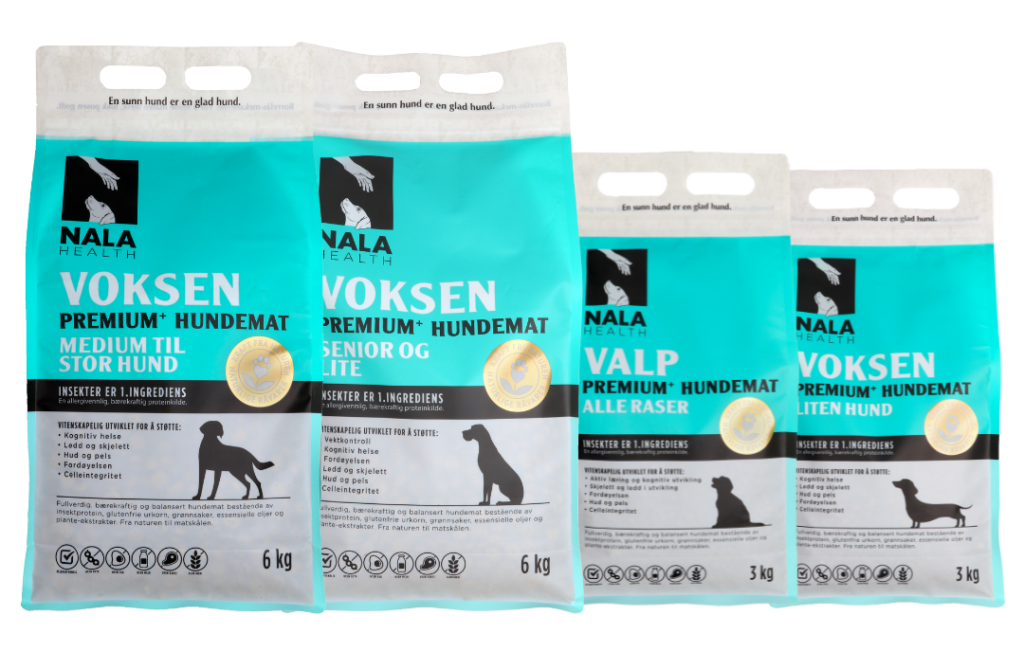Environmental Allergy in Dogs
 Cecilie Hemsen Berg
Cecilie Hemsen Berg
Do you often notice your furry friend scratching incessantly or showing signs of discomfort? Environmental allergies in dogs, commonly referred to as atopic dermatitis, might be the culprit. Much like humans, our canine companions can be adversely affected by their surroundings. From the pollen that dances in the spring air to the silent dust mites residing in our homes, numerous environmental factors can trigger allergic reactions in dogs. In this guide, we’ll dive deep into understanding, management and home treatment of environmental allergies and the symptoms that follow.
What are Environmental Allergies?
Allergies occur when the immune system mistakenly identifies harmless substances, like pollen or dust mites, as threats. When exposed to the “threat”, the immune system will kick into gear to fight these invaders off, which causes an allergic reaction. Factors such as genetics, exposure to specific allergens at a young age, and the overall health of a dog can influence these reactions.

Unlike us, who often get a runny nose and sneeze during pollen season, dogs typically show skin-related symptoms. These can range from persistent itching, redness, and inflammation to secondary infections resulting from continuous scratching.
Common Environmental Allergens
- Pollen: Seasonal changes might bring joy to us, but for some dogs, they signal the onset of allergies.
- Mould: Damp areas in homes can harbour mold, a silent trigger for many pet allergies.
- Dust Mites: These tiny critters love warm, moist places like fabrics, affecting numerous dogs annually.
- Chemicals and Herbicides: The chemicals we use in gardens and homes might be harmful to our pets.
- Bee stings: can cause an anaphylactic response in some dogs. Luckily, anaphylactic reactions are rare in dogs.
- Shampoo and grooming products: Some dogs react to fragrances and other ingredients in grooming products. Opt for formulations for sensitive skin.
- Perfume and scents: Dogs may react to strong scents from perfume, difusers, scented candles and incents.
- Cigarette smoke: Dogs exposed to second-hand smoke have more eye infections, allergies, and respiratory issues including lung cancer. The sense of smell is affected, and dogs can develop a lack of appetite when they cannot smell their food and their surroundings.

Symptoms to Look Out For
- Itchy skin, red and irritated skin
- Constant licking; mostly on the paws
- Swelling of the face, eyelids, ears and lips
- Itchy ears and chronic ear infections
- Runny nose and eyes
- Sneezing
- Diarrhoea/vomiting (most common for food intolerance/allergy)
Treating and Managing Allergies
Navigating the hurdles of environmental allergies in dogs requires vigilance and a multi-faceted approach. Here’s a plan to help:
1. Allergy friendly home
- Cleaning: Swap out chemical-laden cleaning products for natural alternatives. When vacuuming your home, consider placing your dog in a separate room. This is because the vacuuming process can redistribute allergens, exacerbating symptoms.
- Air Purifiers: Useful in redusing indoor allergens.
- Grooming: After outdoor excursions, gently wipe your dog’s paws and fur with a damp cloth. This simple act can remove potential allergens they might have picked up. Use allergy-friendly or sensitive shampoos during baths to further reduce the risk of skin reactions.

2. Medications and vaccinations:
It is important to talk with your veterinarian about the best course of medical treatment that both suits your lifestyle and your wallet. Here are some common medications that are used to manage allergies:
- Anti-histamines: Antihistamines block or reduce the effect of histamines, which are chemicals that the body releases in response to an allergen. Common side effects include drowziness, stomach upset and dry mouth. Only give antihistamines prescribed by your vet and not ones you have for human consumption.
- Steroids/Corticosteroids: Corticosteroids, such as prednosolone, are synthetic versions of the body’s natural steroids. They have powerful anti-inflammatory properties and suppress the immune system. Prolonged use can lead to weight gain, weakened immune system and gastro intestinal ulcers.
- Vaccines: Allergen-specific immunotherapy involves introducing increasing amounts of the allergen to the dog’s system over time, aiming to desensitize the immune system to the allergen. By regularly exposing the dog to controlled doses of the specific allergen, the immune system’s reaction to the allergen may decrease over time, resulting in fewer and less severe symptoms when the dog encounters the allergen in its environment. Side effects include local reactions at the injection site, such as swelling or pain. In rare cases, a more severe allergic reaction (anaphylaxis) can occur. Some dogs may also become more lethargic on injection day.
- Immunosuppressive Drugs: Such as Atopica suppress or reduce the strength of the body’s immune system. Side effects can include increased risk of infections, nausea, liver/kidney dysfunction and increased risk of some cancers.
- Apoquel (oclacitinib): Apoquel is specifically designed to treat itching and inflammation associated with allergic dermatitis in dogs. It works by inhibiting certain enzymes (Janus Kinase enzymes) that are involved in the itch and inflammation response. While many dogs tolerate Apoquel well, some potential side effects include: vomiting, diarrhea, lethargy and decreased appetite.
3. Nutritional Support:
Providing your dog with a nutritionally-rich diet is an important part of ensuring your dog’s wellbeing. Additionally, you can enhance their dietary regimen with the following supplements:
- Omega 3 and 6: Essential fatty acids can offer anti-itching benefits by mitigating inflammation. A balanced diet rich in omega 3/6, zinc, and vitamin B complex, such as Nala Health nourishes the skin and bolsters the immune system.
- Probiotics: Incorporating probiotics into your dog’s diet supports a healthy gut, optimizing nutrient absorption, strengthening the immune response, and facilitating efficient waste excretion.
- Quercetin: A natural antihistamine found in fruits like apples and berries, it’s also available as supplements.
- Nettle Leaf: Recognized for its antihistamine traits, it can be used as tea or supplements. Never feed nettle raw.
- Turmeric: A potent anti-inflammatory, it can be slowly introduced to your dog’s meals.
- Local Honey/pollen: Anecdotal evidence suggests it might assist with pollen allergies. Introduce slowly and in small doses (1-2 grains of pollen in their meal).


In all instances, it’s important to work closely with your veterinarian. They can offer specific guidance tailored to your dog’s unique situation.
Home Remedies for Itchy Skin
Skin irritation and incessant itching in dogs can trigger an increased secretion of sebum, the natural oil of the skin. This excess sebum can sometimes lend the coat an unpleasant, greasy smell. To combat this, consider giving your dog a weekly bath using an allergy-friendly shampoo specifically designed for sensitive skin.
Washes
I used to rinse Nala with a mix of apple cider vinegar and green tea. This can be highly effective in soothing the skin and eliminating foul odours. Mix 1/2 cup of apple cider vinegar, 1/2 cup cooled green tea and dilute with 1 cup of water. Using this mixture, wash the areas most affected by allergies making sure you avoid the eyes. For dogs with itchy paws, you can dip their paws in a bowl of the mixture, one at a time, for about five minutes. After the wash, there’s no need to rinse it off; simply pat your dog dry. Bacteria and fungi do not like an acidic environment, so it can also prevent secondary infections of the skin.

Oatmeal Baths are a time-tested remedy for itchy skin. Oatmeal can reduce inflammation and soothe the skin. To prepare an oatmeal bath, simply grind plain, uncooked oatmeal into a flour using a blender. Then, mix this in warm water. Using a cloth dab your dog with the warm mixture. Ensure the water isn’t too hot, and rinse your dog off after the soak. This can provide immediate relief from itching and is safe to do several times a week.
Topical treatment
Coconut Oil, with its antifungal and antibacterial properties, can be another great remedy. When applied topically, it can alleviate itchy, dry skin by hydrating and reducing inflammation. It’s also beneficial when ingested, as it can improve overall skin health from the inside out. For topical application, gently massage a bit of coconut oil into the affected areas once or twice daily. If choosing to include it in their diet, start with small amounts and consult with your veterinarian for appropriate dosing.
Lastly, Aloe Vera is known for its soothing properties. Applying pure aloe gel to itchy spots can provide immediate relief. However, ensure the aloe is free from any added alcohol or flavorings, as these can irritate the skin further.
REMEMBER Allergy-like symptoms can also occur as a result of other conditions. You must take your dog to the vet so that other issues can be ruled out (hypothyroidism or low thyroid gland production affects the skin and may also worsen allergic skin conditions).

